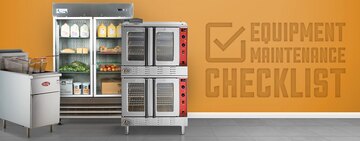If you're looking into buying equipment for your kitchen, then chances are you've seen a lot of information about warranties. They play a pivotal role when it comes to making large purchases, providing assurance that your equipment will work as expected. Nevertheless, warranties can be difficult to understand if you're new to the foodservice industry. We'll explain what a warranty is, the different types of warranties available to you, and specifics about how they work to guide you through the purchasing process and help you if you're equipment starts to fail.
What Is a Warranty?
A warranty is a manufacturer's guarantee that their product will be free of defects and poor workmanship. Whether buying equipment online or in the store, warranties are a safeguard, protecting consumers from receiving a flawed item. If a product fails to meet certain standards, the manufacturer commits to repairing or replacing it. Most warranties are included in the price of a product and issued directly by the manufacturer, ensuring issues are addressed efficiently and effectively.
Each issuer sets the guidelines for their own warranties, including what is covered and the specified coverage time frame. Some warranties last 5 years, while others only last 30 days. It’s important to read and understand the warranty document included with your purchase so you are aware of the details and limitations associated with it.
Types of Warranties
There are two general types of warranties commercial equipment can come with: express warranties and implied warranties. Both types have sub-categories, which vary depending on specific factors and the equipment you've purchased. In some cases, multiple warranties can apply at the same time.
1. Express Warranty

An express warranty is a clear and definite written guarantee from a manufacturer that their product will perform as intended. According to federal law, a company providing an express warranty is subject to federal guidelines, ensuring they follow up and provide the necessary services outlined in the warranty. Most express warranties are found in your product documents or user manual, while others are featured in advertising materials or on the packaging of your product. In the realm of restaurant equipment, there are four common express warranties you can expect to encounter:
- Parts and labor warranties: A parts and labor warranty covers the cost of a technician and replacement parts. Work with the manufacturer to arrange for an authorized technician, as repairs performed by anyone else could void your warranty.
- Replacement warranties: With a replacement warranty, the manufacturer will send a replacement item instead of paying for repairs. After you receive a replacement, the warranty does not renew but keeps the same expiration date.
- Specific parts warranties: These usually cover one component of your unit that is essential for it to function. For example, refrigerated equipment often has a compressor warranty that is only good for replacing the compressor.
- Extended warranty: An extended warranty is an optional warranty that can be added to your initial purchase. It covers repairs, defects, or damages not included in the manufacturer’s warranty. They can be obtained from the manufacturer or through the business you purchased the equipment from, and the issuer should be clearly stated on your warranty document.
2. Implied Warranty
An implied warranty does not need to be explicitly expressed in writing to be valid. Rather, it is automatically assumed to exist based on statements or representations the manufacturer makes, which are considered assurances it will work as intended. If it does not, the consumer may be entitled to repairs, replacements, or other remedies, as specified by consumer protection laws. Implied warranties are less common in foodservice equipment, as most products come with extensive documents and written warranty information. Nevertheless, there are a few types of implied warranties that may apply to your equipment:
- Warranty of merchantability: A warranty of merchantability ensures the items you purchase are fit for their ordinary purposes. In other words, when you buy a piece of equipment, you can reasonably expect that it will function without any defects that would hinder its performance.
- Warranty of fitness for a specific purpose: When a consumer relies on the advice or guidance of the manufacturer regarding the suitability of a product for a particular use, the warranty of fitness for a specific purpose comes into effect. It certifies that goods are suitable for their intended use, and the seller is liable if it doesn't perform as expected.
- Warranty of title against infringement: This guarantees the seller has clear ownership of the goods sold and legal authority to transfer that ownership to the buyer. The buyer can be confident they are acquiring goods free from liens, claims, or other encumbrances that could affect their ownership rights. This also protects the buyer from any claims by third parties asserting that the purchased goods infringe on their intellectual property rights.
Where Are Warranties Found?

Depending on the type of product you purchase or the seller you went through, warranties can be found in a few different places. Always keep a copy of your warranty for your records or note where to find it once you receive your equipment.
- User manuals: Most warranties are included on the last page of your user manual.
- Digital downloads: If you purchased your equipment through a wholesaler or independent company, their website will likely have replacement copies of your warranty available for digital download.
- Product packaging: In some cases, warranties may be included on your equipment’s original packaging or product tag.
- Contract documents: If you entered into a sales contract when purchasing your equipment, warranty information should be attached to the contract documents. This ensures that all terms and conditions related to the warranty are clearly outlined and easily accessible.
- Advertising materials: Implied warranties can be found in product and equipment advertising materials.
Warranty Limitations
While warranties aim to provide comprehensive coverage, certain limitations affect the extent of the service a manufacturer can provide. Understanding these warranty limitations can help you manage your expectations and plan accordingly in case you encounter any issues with your commercial equipment.
- Location: If you live in a remote area where no authorized technicians are available, it can be challenging for manufacturers to provide full services. Similarly, warranties may only cover a specific distance, and any locations beyond that distance may require the customer to cover the technician's travel expenses.
- Zoning and use restrictions: Some technicians aren't insured to make repairs in residential locations. Additionally, certain manufacturers may not provide warranty coverage for purchases made outside the United States.
- Parts coverage: Wear-and-tear parts, such as gaskets or light bulbs, are frequently replaced in commercial settings. As such, they are not covered by most warranties.
- Wait times: Depending on the schedule of authorized technicians near you, there may be a long wait time for service.
- Used equipment: In most cases, you won't be able to get a warranty when buying used equipment.
- Shipping issues: Generally speaking, damages that happened during shipping are not covered under warranty. This would include dents, scratches, or breaks incurred from dropping the item or improper handling. Instead of making a warranty claim, shipping damages should be pursued through the merchant's customer solutions team.
What Voids a Warranty?

Even if you've purchased a warranty and are eligible for service, certain conditions cause it to be void. A void warranty is invalid and provides no coverage, leaving you to find a different way to replace the equipment. Note that every warranty is specific to the products it covers, but some common mistakes can easily be avoided.
- Improper installation and maintenance: Ignoring the manufacturer's recommended installation and self-maintenance guidelines can lead to malfunctions or breakdowns, which aren't covered under your warranty.
- Residential use: Using commercial equipment in a residential setting can be dangerous and cause significant damage to the unit.
- Damage from negligence: Your warranty will be void if the equipment is misused or abused, as this type of usage puts undue stress on the product and can lead to premature failure.
- Unauthorized repairs: Altering the equipment from its original state, including attempting complex repairs yourself or using unauthorized parts or service providers, can compromise its safety and performance, making it ineligible for warranty coverage.
- Usage in extreme conditions: Exposing equipment to extreme temperatures, excessive moisture, and harsh environmental factors not recommended by the manufacturer will likely void the warranty.
How to Make a Warranty Claim
If you've never submitted one, making a warranty claim can be confusing. It is good practice to file away all your warranties and receipts, as this serves as proof of purchase. Keep track of manufacturer contact information, usually located at the top or bottom of the warranty document. If a phone number is not listed, you can contact the store where you purchased the unit to obtain it. After submitting your claim, the manufacturer must approve it, and though the exact approval process can vary between companies, there are generally a few standard steps you can take to move the claim forward.
- Send digital images of the defect to the manufacturer: This proves your claim is legitimate and helps the manufacturer determine whether repairs or a replacement are necessary.
- Send the entire unit back to the manufacturer for inspection: The manufacturer can inspect the unit at their facility and send it back to you in working order.
- Allow an authorized technician to inspect the unit: The technician can fix the unit on-site or recommend a replacement.
What Is WebstaurantStore’s Warranty Policy?
WebstaurantStore may offer an extended warranty on select items. This warranty can be selected at the time of purchase and goes into effect after the manufacturer's warranty has elapsed. The issuer of the warranty, whether it's WebstaurantStore or the manufacturer, will be clearly stated on the warranty document. For more information about our warranties, reference our FAQ page.
Back to TopMaking a warranty claim isn't always convenient, especially in a busy restaurant environment. However, submitting one will be a great benefit to you if your equipment is truly defective. Warranties provide peace of mind in case your equipment fails, allowing you to quickly get your workplace back to full strength. By familiarizing yourself with the different types of warranties and how they function, you can stay prepared for anything that comes your way.








